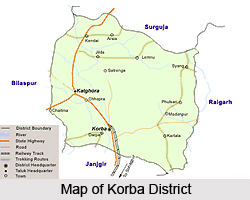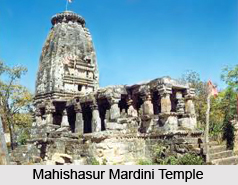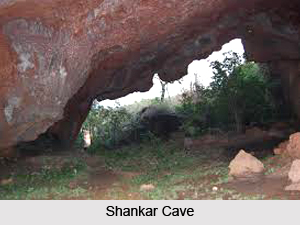 Korba District of Chhattisgarh comes under the Bilaspur division and is inhabited mainly by tribal people including the protected Korwas (Pahadi Korwa). Korba District was accorded the status of full fledged revenue district with effect from 25th of May, 1998. The district headquarter is Korba city, which is situated on the banks of the confluence of rivers like Hasdeo river and Ahiran river.
Korba District of Chhattisgarh comes under the Bilaspur division and is inhabited mainly by tribal people including the protected Korwas (Pahadi Korwa). Korba District was accorded the status of full fledged revenue district with effect from 25th of May, 1998. The district headquarter is Korba city, which is situated on the banks of the confluence of rivers like Hasdeo river and Ahiran river.
Location of Korba District
Korba District is located between latitude 22 degrees 1 minute to 23 degrees 1 minute and longitude 82 degrees 8 minutes to 83 degrees 9 minutes. Its height above the sea level is 304 metres. Korba District is situated in the northern half of the Chhattisgarh and surrounded by the districts Korea, Sarguja, Bilaspur, Janjgir etc. The headquarters of Korba District is situated around 200 kms from the capital city Raipur. The total area of the district is 7, 14,544 hectares out of which 2, 83,497 hectares account for forest land.
Geography of Korba District
Geography of Korba District includes several rivers and forests. The main river which is flowing through Korba district is the Hasdeo River that starts in the valley of Chota Nagpur.The total length of this river is 233 kilometers. Its tributaries are Gagechorai, Tan and Ahiran. Forests play an important role in the social and financial structure of Korba District. This district is rich in forest wealth. Korba District has two forest divisions Korba and Katghora. Korba District falls under the hot temperate climate zone and hence the district experiences very hot and dry weather. Summer season starts from April to mid June. Rainy season due to the South-West Monsoon is from mid June till the end of September. The average rainfall in the district is 1506.7 mm and normal rainfall is 1287.6 mm.
 Culture of Korba District
Culture of Korba District
People of Korba District come under different religious, social and cultural backgrounds. The main inhabitants of this district are tribes. Tribal communities constitute the majority (near about 51 per cent) of the total population. The main scheduled tribes of this district are Pahadi Korwa Tribe, Gond Tribe, Raj Gond Tribe, Kawar Tribe, Bhaiyana Tribe, Binjwar Tribe, Dhanwar Tribe etc. Their main occupation is agriculture. The local language is Chhattisgarhi language. Korba District is famous for its social and cultural diversities. The people of this district mainly celebrate Holi, Dussehra, Christmas and Diwali. The main adivasi festivals are Dev Uthni Festival, Pola Festival, Cherchera Festival, Karma Festival, Hareli Festival and more. Ravat Nacha Karma Nacha, Suva Nacha are the traditional dances of the Adivasi`s of Korba District. The tribal communities of this district have retained their distinctive cultural characteristics and traditional observances.
Tourism in Korba District
There are various attractive tourism options in Korba District. Like for instance, Chaithurgarh is a major attraction that is situated around 70 kms away from Korba town. Archeologists consider it as one of the strongest natural fort.
 Since it is protected by strong natural walls, only at some places walls have been built. The fort has three main entrances which are named as Menaka, Humkara, and Simhadwar. Another tourist attraction of this place is Mahishasura Mardini Temple. The idol of Mahishasura Mardini having 12 hands is installed in the sanctum sanctorum. Shankar cave is situated 3 kms away from the temple. The cave which is like a tunnel is 25 ft long. One can go inside the cave only by creeping since it is very short in diameter. The hillocks of Chaithurgarh are famous for its natural beauty and the adventurous experiences it offer. Many types of wild animals and birds are found here.
Since it is protected by strong natural walls, only at some places walls have been built. The fort has three main entrances which are named as Menaka, Humkara, and Simhadwar. Another tourist attraction of this place is Mahishasura Mardini Temple. The idol of Mahishasura Mardini having 12 hands is installed in the sanctum sanctorum. Shankar cave is situated 3 kms away from the temple. The cave which is like a tunnel is 25 ft long. One can go inside the cave only by creeping since it is very short in diameter. The hillocks of Chaithurgarh are famous for its natural beauty and the adventurous experiences it offer. Many types of wild animals and birds are found here.
Korba is often referred as the Industrial Hub of Chhattisgarh. The district is enriched with all the essential raw materials needed for power generation namely coal and water. The four Thermal Power Plants (KSTPS, BCPP, CSEB East, and CSEB West) together generates 3650 MW of electricity. Besides these, there is a Hydro Electric Power Station situated at Bango. Coal is abundantly found in the district.






